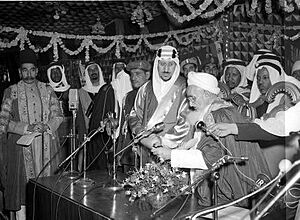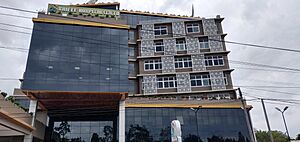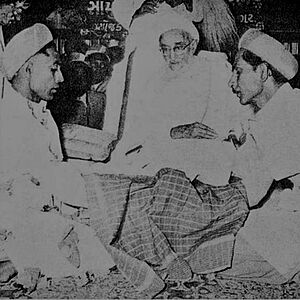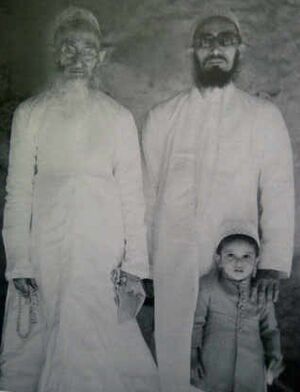Taher Saifuddin facts for kids
Quick facts for kids Taher Saifuddin |
|
|---|---|
| طَاهر سيف الدِّين | |
 |
|
| Religion | Islam (Shia Islam) |
| Sect | Isma'ili Dawoodi Bohra |
| Personal | |
| Home town | Mumbai |
| Born | Taher 4 August 1888 Surat, British Raj |
| Died | 12 November 1965 (aged 77) Matheran, India |
| Resting place | Raudat Tahera, Mumbai |
| Spouse | Husaina |
| Parents |
|
| Senior posting | |
| Title |
|
Taher Saifuddin (born August 4, 1888 – died November 12, 1965) was a very important leader for the Dawoodi Bohra community. He was their 51st and longest-serving leader, known as the Da'i al-Mutlaq.
Saifuddin helped the community grow by bringing in new ideas from Western countries. He made sure these changes helped the Bohras, while still keeping their old traditions. He worked hard to improve education, help people, and connect with others. His work set a strong foundation for future leaders, making the Dawoodi Bohra community very successful.
Contents
Early Life
Taher Saifuddin was born in Surat, British India (now Gujarat), on August 4, 1888. His father was Mohammed Burhanuddin I, and his mother was Amatullah Aaisaheba.
A Great Leader

Saifuddin became the 51st Da'i al-Mutlaq in 1915 when he was 28 years old. During his time as leader, he rebuilt and fixed many important buildings. These included monuments of past leaders and other historical structures.
Focus on Education
Saifuddin believed strongly in education. He helped set up over 350 schools for both boys and girls. Some of these schools are named after him, like Aljamea-tus-Saifiyah in Surat. Other examples include Saifee Hall in Calcutta and Saifiyah Girls School in Karachi.
Later, his son, Mohammed Burhanuddin, organized these schools under the name MSB Educational Institute. These schools are now in many cities around the world. Saifuddin also became the Chancellor (a top leader) of Aligarh Muslim University in 1953. He held this position for four terms. While he was Chancellor, the first Prime Minister of India, Jawaharlal Nehru, helped start the Maulana Azad Library at the university. It became one of Asia's largest libraries.
Aljamea-tus-Saifiyah
Saifuddin used his own money to improve Dars-e Saifee, a school for Islamic studies. He turned it into a university, adding regular school subjects and connecting it with international schools. He then renamed it Aljamea-tus-Saifiyah, which means "The Saifiyah University."
Just like leaders before him, Saifuddin made sure students at Aljamea received free housing and meals. He also made a big change by allowing the first female students to join the university. Saifuddin himself taught some classes at the new university. He also created new study plans and wrote many important books that became part of the school's lessons. These books are still taught today, along with other religious and regular subjects.
After Saifuddin, his son Burhanuddin made Aljamea even bigger. He added new campuses in places like Karachi, Nairobi, and Mumbai. The graduates from Aljamea are now very important to the Dawoodi Bohra community.
Community Service

Saifuddin started Bunaiyat-tul-Eidiz-Zahabi in the 1950s. This was a group of Dawoodi Bohra women who volunteered to help the community. This idea led to other groups being formed later, like the Burhani Womens Association.
He also created Shabab ul-Eid iz-Zahabi, a group for Dawoodi Bohra men. This group was formed during the celebrations of his 50 years as leader. Its main goal was community service. His son, Mohammed Burhanuddin, later started other groups like the Burhani Guards, who help with crowd control at religious events.
Rasm-e Saifee
To help make marriages easier and more affordable, Saifuddin started Rasm-e Saifee (which means "The tradition of Saifee"). He began this in Jamnagar around 1952 and made it an official practice around 1963.
Rasm-e Saifee is a special event where many marriages (called Nikah) happen at the same time. The Da'i al-Mutlaq or his representatives perform the ceremonies. His son, Burhanuddin, later created the International Taiyseer al-Nikah Committee (ITNC) to organize these events throughout the year. The current leader, Mufaddal Saifuddin, continues this tradition today.
Helping Islamic Places
Saifuddin gave a lot of money to fix and improve mosques and holy shrines. He was one of the few Indian Muslims who helped renovate Al-Aqsa Mosque in Jerusalem. He also gave special curtains that were kept inside the Kaaba in Mecca to Ibn Saud, the King of Saudi Arabia.
He built the Ghurrat-ul Masajid (meaning "Pride of Mosques"), also known as Saifee Masjid, in Mumbai. He also built a palace for pilgrims in Mecca and special structures for the tombs of important figures in Najaf, Karbala, and Cairo. He even made and donated the kiswah, which is the cloth covering the Masjid al-Haram in Mecca.
Family Life
Saifuddin first married Husaina Aaisaheba. After she passed away, he married Vazira Aaisaheba, Fatima Aaisaheba, and Amina Aaisaheba. He had 12 sons and 8 daughters. His most famous son was Mohammed Burhanuddin, who became the next Da'i al-Mutlaq.
His Writings
Saifuddin wrote many important books and letters, especially a series called Rasāʾil Ramaḍāniyya. These writings were often titled with names that matched the Hijri year they were published. They shared important religious knowledge and guidance for the community.
Awards and Recognition
Saifuddin received special honors for his work. Aligarh Muslim University gave him a Doctor of Theology degree in 1946. Later, Karachi University also gave him a Doctor of Laws degree around 1955. He was also voted among the "100 Greatest Indian Muslims of the Twentieth Century" in a public poll.
Death and Burial

Taher Saifuddin passed away on November 12, 1965, in Matheran, India. He is buried in Raudat Tahera, a beautiful mausoleum in Mumbai. His son, Mohammed Burhanuddin, built this mausoleum.
His Legacy
Saifuddin left behind many important contributions that continue to help people today.
The Dandi Memorial
Saifuddin donated his home, Saifee Villa, in Dandi, Navsari, to the government in 1961. This was a very special place because Gandhi stayed there during his famous Dandi March against the British Salt Laws. The house was later turned into a National Museum.
Aligarh Muslim University
A school at Aligarh Muslim University is named the Syedna Taher Saifuddin School in his honor. He was the longest-serving Chancellor at the university, holding the position for 12 years.
Hospitals
Saifee Hospital in Mumbai was built by his son, Mohammed Burhanuddin, and dedicated to Saifuddin. It opened in 2005 and was one of the first hospitals to help during the 2008 Mumbai Terror Attacks. Another hospital with the same name, Saifee Hospital, Karachi, was built in Karachi by his son as well.
Housing Projects
In 2009, Mohammed Burhanuddin started the Saifee Burhani Upliftment Trust (SBUT). This project aims to rebuild and improve a large area in Bhendi Bazaar, Mumbai. It was dedicated to his father, Saifuddin. This project is now a model for other city development plans.
Remembering Him
Every year, Saifuddin's death anniversary (called urs) is remembered by the Da'i al-Mutlaq at Saifee Masjid in Mumbai. Also, the annual exams at Aljamea-tus-Saifiyah begin after the leader gives sermons remembering Saifuddin.
Memorials
After Saifuddin's death, his son Mohammed Burhanuddin created the His Holiness Dr. Syedna Taher Saifuddin Memorial Trust in 1966. This trust helps provide money for education and medical care.

His son also set up the Matheran Memorial Hall. This is a museum and a place for visitors in Matheran, where Saifuddin passed away.
See also
- List of Dai of Dawoodi Bohra







